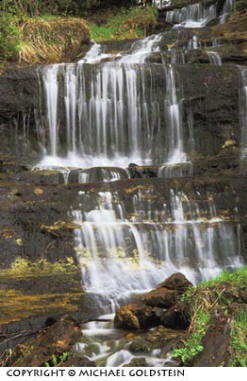
Alger Falls
Photographing Alger Falls requires a bit of physical maneuvering, to avoid the need to shoot through a grove of young trees. Alger Falls is located right beside highway 94, just outside
Munising, Michigan. Use of a polarizing filter is always a good idea when photographing water. A low aspect, using a 24mm lens, allowed me to include an interesting foreground.
The use of slow shutter speeds, that produce “veils” on moving water,
requires that you use low ISO or slow film, and have black, foreboding skies
overhead. Autoexposure techniques will yield good results with this kind of composition, as “brights and darks” are almost equally present in the image.
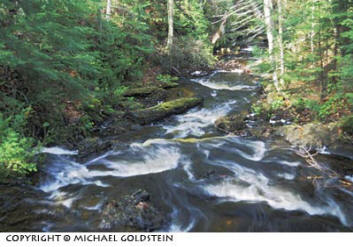
Chapel Falls
Chapel Falls is a very pretty little cascade, requiring a pleasant walk on a well marked trail through the woods, to reach it. A 24mm zoom lens allowed careful cropping, to produce exactly the desired photograph from the trail, without walking in the water.
This cascade was photographed on a rather bright and sunny day, as evidenced by the contrast range in the image. Lights and darks were well balanced, so auto-exposure was a good choice here (Nikon’s “3D Matrix Metering”, and auto-exposure, does an excellent job under these circumstances).
It’s difficult to avoid hot highlights when photographing waterfalls under these lighting conditions, and well-nigh impossible to produce “veils” on the water.
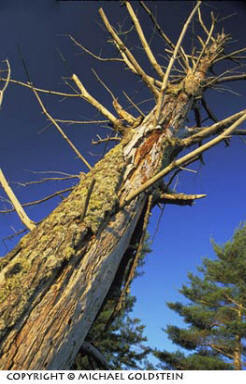
Dead Tree
This image was made on a lovely sunny evening, on the Lake Superior shore, at Sand Point, just outside Munising, Michigan. This old soldier was glowing in the late afternoon light, lovely against a blue sky. A blue-yellow polarizer enhanced the glowing effect, while darkening the sky, and tilting the camera produced a more dynamic composition.
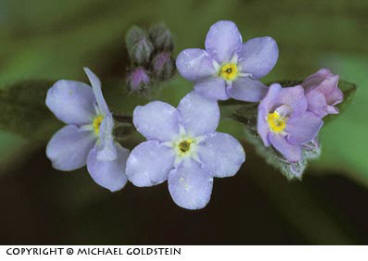
Forget-me-not
Photographing this clump of forget-me-nots required use of my 90mm macro lens. A cloudy sky provided just the right kind of lighting. Making portraits of flowers needs careful composition, together with a lot of “surveying” to find just the kind of grouping you require. Careful adjustment of depth-of-field is a must, to ensure the subject is in focus, while the background is as diffused as is possible.
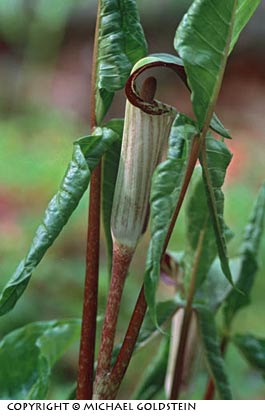
Jack in Pulpit
This is perhaps the best image I’ve yet made of the jack-in-the pulpit, as it’s usually necessary to include “jack”, who hides under that curled-over leaf.
This jack, unlike the majority of his cousins, was a rather high plant, and was growing on a slight bank beside the hiking trail. This made it possible to get low enough for a good sideways view.
A 180mm macro lens was used, together with a diffuser to block most of the sunlight that was falling on the plant. Several brawny photographers were employed in throwing shadows on the background. To use matrix metering and autoexposure was an easy decision here.
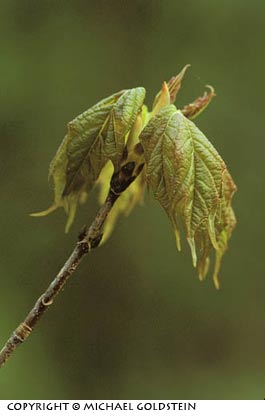
Juvenile Maple Leaf
Once you enter the macro world, you begin to realize that there is a wealth of nature subject material available, over and above the usual wildflowers. In this case, a maple leaf, just out of its casing in mid-May, seemed like a good photo opportunity. The camera was tilted to make a dynamic composition, with the leaf placed to occupy the upper third of the frame, more or less. The background was easily diffused, as the leaf was quite a distance away from the surrounding woods.
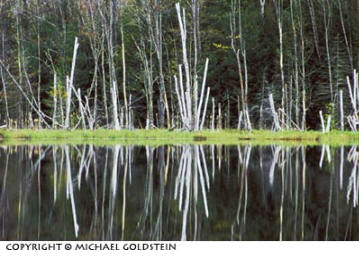
Lake Reflections
This image was made at Red Jack Lake, just after dawn, on a very still morning. Every effort was made to create a symmetrical composition – including a mid-frame horizon line, as this seemed to be an opportunity to break the rules.
I was tempted to try to spot-meter on the white stumps, but the bright area was not large enough, so I used matrix metering and auto-exposure, and added -1 f-stop of compensation to avoid overexposure. I then bracketed my exposure around that setting.
While we were photographing here, we could hear sandhill cranes calling, somewhere back in the woods.
By Michael Goldstein

Leave a Reply